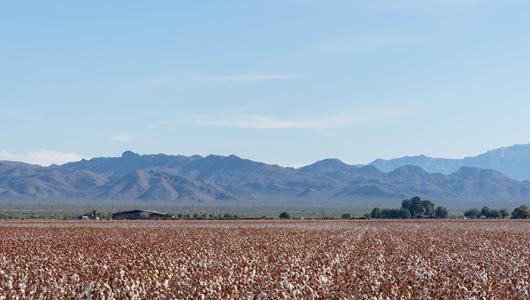Wool, known for its warmth and breathability, is great for winter weather hats, sweaters and coats. But the wool fibers from a northern California sheep ranch offer carbon-conscious consumers added values.
For nearly a decade, ranch owner Lani Estill has worked with the USDA Natural Resources Conservation Service to improve soil health on the pastures grazed by her sheep. By adding key conservation practices, the ranch's pastures now store more carbon in the soil than it emits through its operations.
Estill and her family raise sheep and cattle on her 40,000-acre ranch, which overlaps the border of California and northwest Nevada.
Conservation Commitment
Bryon Hadwick, NRCS District Conservationist in Alturas, California, works closely with Estill and Bare Ranch to implement conservation practices that are good for the land, animals, atmosphere, and their business. With help from her local NRCS offices and supported by Environmental Quality Incentives Program or EQIP contracts, Estill has:
- improved sage grouse habitat by removing thousands of acres of invasive juniper;
- planted hedgerows for pollinators;
- installed fencing and livestock watering facilities;
- and began following a prescribed grazing management plan.
Additionally, Bare Ranch worked with NRCS and several other partners to develop and adopt a Carbon Farm Plan, the key for establishing their special marketing niche.
“The Bare Ranch conservation plan represents a partnership and a commitment to sustainability,” said Hadwick. “Through this partnership, the Estill Family is demonstrating that conservation, environmental benefits and profit can all be generated simultaneously.”
Carbon Accounting
Guided by Estill’s goals and developed using the NRCS’ conservation planning process, the science-based Carbon Farm Plan incorporates data from USDA measurement tools like COMET-Planner and COMET-Farm. These whole farm and ranch tools serve as a greenhouse gas and carbon sequestration accounting system for the operation.
The Bare Ranch Carbon Farm Plan prioritizes practices that sequester carbon, add perennial biomass, and grow healthy forage. It assesses the ranch’s ecology and soils, and then recommends management practices to improve soil health and sequester more carbon in the soil and perennial biomass. Conservation practices that build the land’s carbon reserves can increase resilience to changing conditions, enhance overall productivity, and improve the water-holding capacity of the ranch’s soil.
Meeting Market Demand
As the public becomes increasingly aware of the environmental impacts of their food and other consumer products, many ag producers and manufacturers are turning natural resource conservation practices into a competitive business advantage.
By measuring the impact of their conservation practices, Bare Ranch has provided the transparency and quantified conservation value of their wool production that companies and consumers are seeking.
You can learn more about the Bare Ranch story by listening to this Capital Public Radio story.


